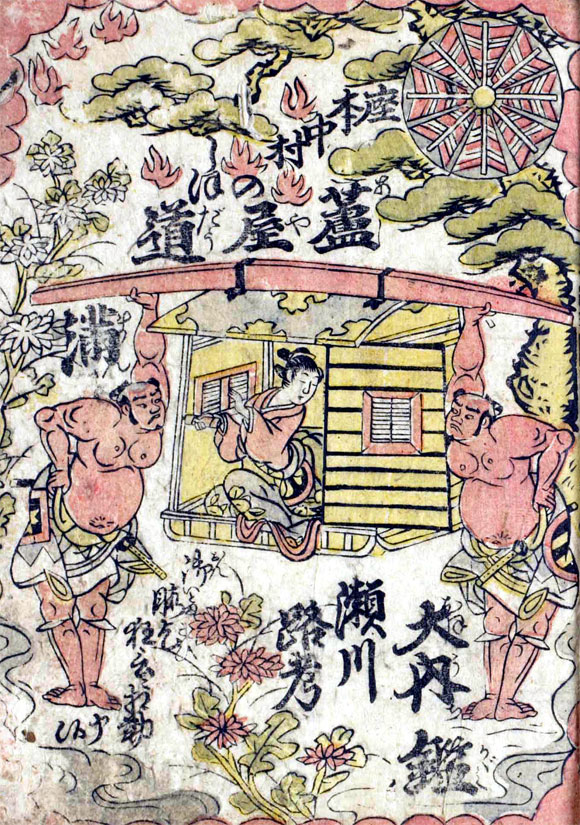| ASHIYA DÔMAN ÔUCHI KAGAMI |
| Play title | Ashiya Dôman Ôuchi Kagami |
| Author | Takeda Izumo I |
| History |
The play "Ashiya Dôman Ôuchi Kagami" was originally written for the puppet theater (Bunraku) and staged for the first time in the 10th lunar month of 1734 in Ôsaka at the Takemotoza. It was adapted for Kabuki the following year and staged for the first time in the 5th lunar month of 1735 in Kyôto at Miyako Mandayû's theater [casting]. There are many legends about the court astrologer Abe no Seimei and this five-act puppet play shows his birth and culminates with a contest of magic. One of the legends about Abe no Seimei is that his magical powers come from the fact that his mother was actually a fox. Narrative songs about Seimei (known by his childhood name of Dôji) and his parting from his fox mother, as well as the efforts of his father Yasuna to find her in the forest of Shinoda are especially in the Buddhist narrative style called sekkyô-bushi. The full-length play is performed occasionally today, but the most familiar scene is the fox Kuzu-no-Ha's parting from her son. This scene, entitled "Kuzu-no-Ha", is performed frequently today both in Bunraku and Kabuki. Also, the mad scene of Yasuna has been transformed into a separate dance, "Yasuna", which is one of the most important pieces of the Kiyomoto style of narrative music. |
| Structure |
"Ashiya Dôman Ôuchi Kagami" is made up of five acts. |
| Key words |
Abe no Seimei Gidayû Kyôgen Jidaimono Kowakare Onmyôdô Onmyôji Sekkyô-bushi |
| Summary |
In the full-length play, Abe no Yasuna is a student of the late court astrologer Kamo no Yasunori and is supposed to marry Yasunori's adopted daughter Sakaki-no-Mae. However, there is an important ceremony to show that Sakaki-no-Mae has proper possession of the books of magic belonging to her father and villains have stolen them. She commits suicide to atone and Yasuna is driven mad with grief. As he wanders through the countryside, he comes to his senses and rescues a fox that is being chased by hunters. In gratitude, this magical fox takes the form of Sakaki-no-Mae's younger sister Kuzu-no-Ha and lives with Yasuna quietly in the country. They have a son named Dôji. The boy is strong-willed and mischievous and loves to kill and eat insects and small animals. Kuzu-no-Ha grieves that this a sign that her animal nature has been passed on to her son. But one day, the real Kuzu-no-Ha and her parents Shôji and his wife come searching for Yasuna and they are surprised to find another Kuzu-no-Ha. At this point, the fox Kuzu-no-Ha knows that she must leave and she tearfully parts from her husband and son. She writes a poem on the paper screens which means, "If you would search for me, go to the forest of Shinoda." Her hands gradually change back to animal paws and the final lines of the poem are written with the brush held in her mouth. Yasuna, Dôji and the real Kuzu-no-Ha go to try to persuade the fox Kuzu-no-Ha to return, but she says that she is a messenger of the gods and cannot have any more close contact with human beings. But she will always watch over Dôji. In the final scenes of the play, there is a contest of magic between Dôji and his arch-rival, Ashiya Dôman. |
 |
|
Fujikawa Hachizô III (left), Segawa Rokô III (center) and Kataoka Nizaemon VII (right) playing the roles of the yakko Yokanpei, the fox Kuzu-no-Ha and the yakko Yakanpei in the drama "Ashiya Dôman Ôuchi Kagami", which was staged in the 9th lunar month of 1804 at the Kado no Shibai (cover for an ezukushi banzuke) |
|
|
| Contact | Main | Top | Updates | Actors | Plays | Playwrights | Programs | Links | FAQ | Glossary | Chronology | Illustrations | Prints | Characters | Derivatives | Theaters | Coming soon | News |